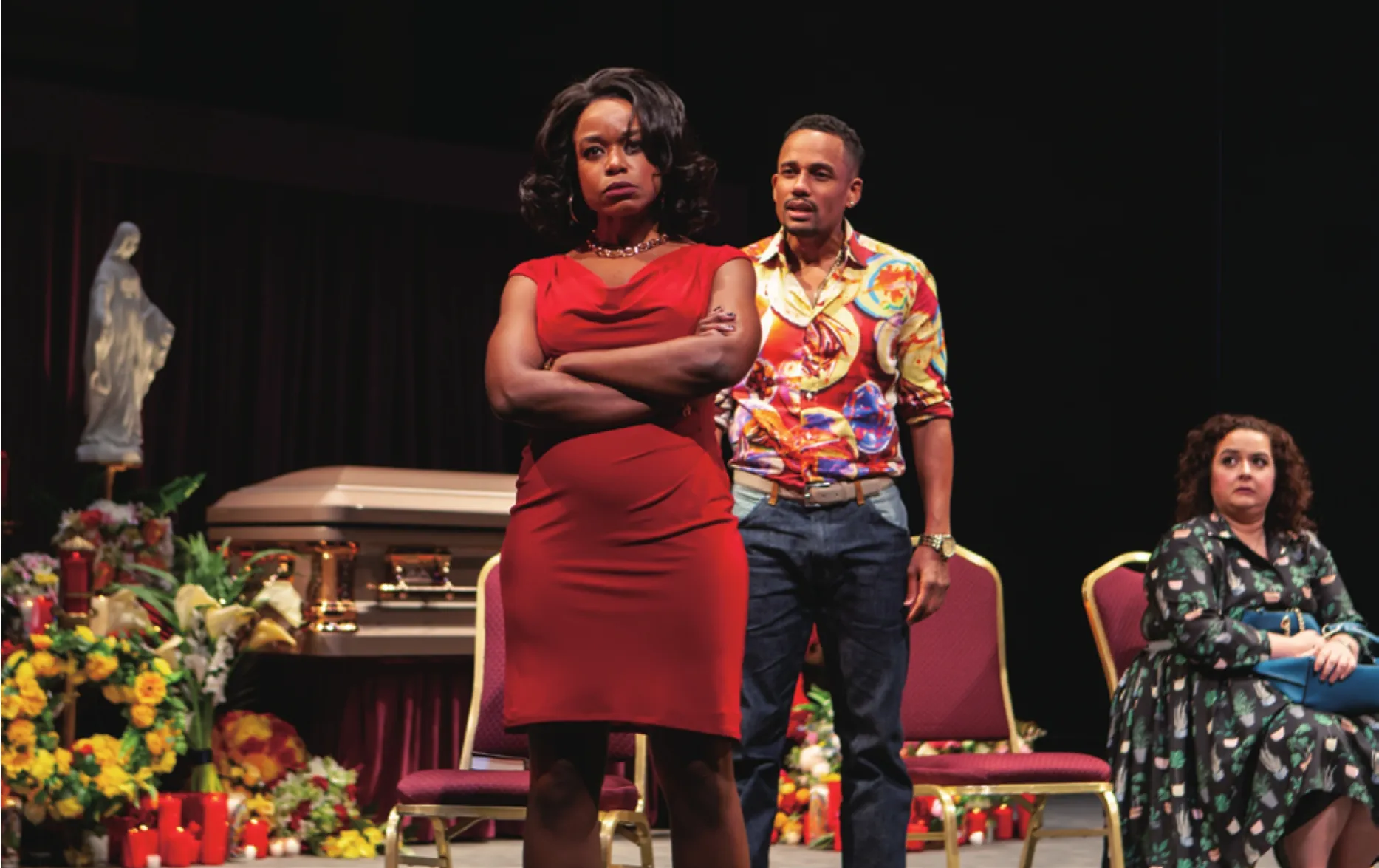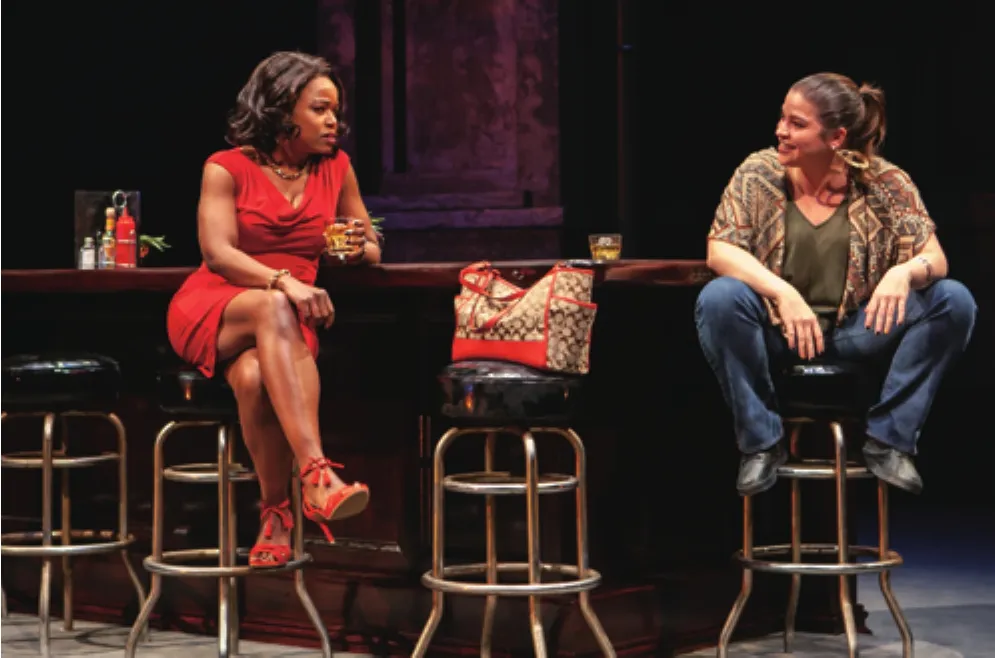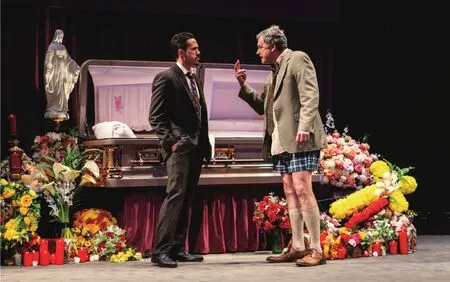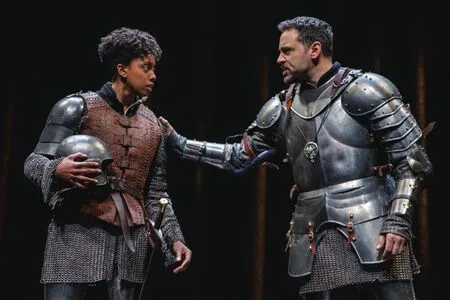灰色的梯度:探讨多样化
2018-07-13司马勤KenSmith编译李正欣
文:司马勤(Ken Smith) 编译:李正欣
几周前在马德里举行的世界歌剧论坛上,短短的两天时间内,我被灌输了诸多热血沸腾的、关于“多样化”的言论——说这些话的人大多来自美国。其实,在大环境下,这个议题的回响寥寥——我们的世界已经够多样化了——可是,当你把这个话题放到美洲,后果就会显得十分严重。不信你去问问多伦多人。

© MONIQUE CARBONI / COURTESY OF THE SIGNATURE THEATRE
5月底,加拿大歌剧院与多伦多交响乐团失去了大约百分之十的资助,因为它们“没有达到市政府多样化的目标”。这个结论是否合理,很难界定。我可以肯定,政府会找出各种借口来减少艺术资助以节省预算。尽管如此,为了歌剧艺术的未来,每一家机构都必须认真地正视“多样化”这个议题。
要吸引“多样化”的观众来看歌剧的话,最合乎逻辑的方法就是找来不同种类的人在舞台上亮相。以我肤浅的推算,可以归类为三个大方向:1.创作一些新作品,题材环绕少数族裔的生活经验;2.搬演传统剧目的时候,选角“不分肤色”(英语俚语colorblind,直译是“色盲”);3.在传统剧目选角的时候,刻意挑选某些族群的演员,目的是凸显“种族”的差异。无巧不成书,上一次回到纽约时,我竟然真的在一周之内,碰上了这三种方向的不同个案。
属于第一类的案例,是署名剧院(Signature Theatre)重演的《121街的修女》(
Our Lady of 121 Street
)。编剧史蒂芬·阿德利·桂吉斯(Stephen Adly Guigis)不是黑人,但他熟知哈林(Harlem)区,这个著名的黑人区正是故事发生的背景地。这部首演于2002年的话剧里有黑人,也有同性恋者——包括一位黑人同性恋者——还有传统信奉基督教的白种欧洲族裔(White Anglo-Saxon Protestants,简称WASP)与来自爱尔兰的天主教徒。这些人物走在一起势必会燃起战火,而他们针锋相对的言论更带来一触即发的危机。桂吉斯笔下的台词比另一位著名编剧更加尖锐——相较而言,大卫·马麦特(David Mamet)所用的粗言秽语听起来就像苏斯博士(Dr.Seuss,20世纪最卓越的儿童文学家、教育学家)笔下的儿童故事那样天真无邪。但最起码,这次的公众媒体还能够刊登出话剧的剧名(桂吉斯于2011年创作的另一部作品剧名包含极下流的词汇,杜绝了任何媒体刊载的可能性)。我们先撇开那些粗鄙的词汇不谈,桂吉斯的确是一位极有才华的编剧。当年《121街的修女》的首演赢得了多项外百老汇奖项,也被各大剧评人选入“2003年十大最佳剧目”之列。到了2015年,桂吉斯的《河畔大街与癫狂之间》(
Between Riverside and Crazy
)更赢得了当年的普利策戏剧大奖。因此,请不要小觑这位编剧。可是,我们需要慎重地处理他的作品:如果导演的力度过于柔软,剧中的幽默不复存在;如果过于强硬,角色人性的一面就很难引起共鸣。当年该剧首演时我失之交臂[导演是已故演艺巨子菲利普·塞默·霍夫曼(Philip Seymour Hoffman)],幸好这回署名剧院的制作由菲利西亚·拉沙德(Phylicia Rashad,美国著名黑人女演员、歌手、舞台导演)执导,效果恰到好处。

上、左页:《121街的修女》剧照
看起来有点反讽,因为公众对拉沙德女士的印象,无法跳脱出她在历时八年的长寿电视剧《考斯比一家》(
The Cosby Show
, 1984~1992)中扮演的考斯比太太的模样。电视里那个十全十美的美国非洲裔家庭与121街中那些极不靠谱的人物,距离十万八千里。要复述桂吉斯的故事大纲太艰难了,因为这部话剧并没有什么主轴情节。“修女”没有亮相,因为在大幕拉开前她已去世,本来放在殡仪馆的遗体也被偷走了。前来参加丧礼的人们——她从前教导过的学生——也没有机会为她送别。这看起来,是展示不良行为的最佳借口。
尽管人物设定十分夸张却百分百拥有人性,这归功于演员的功力。演员之间合作无间,每一位角色进退得宜,舞台焦点突出,这得归功于导演拉沙德。除此之外,大家对剧本的了如指掌、处理适中,可见一斑,让字里行间透出严肃性,而不会沦为仅仅只具侮辱性的喜剧。
拉沙德出生于休斯敦,双亲都是专业人士,年幼的她的生活环境可能更接近《考斯比一家》而不像是“121街”。尽管如此,拉沙德熟知桂吉斯笔下的各类人物。即便他们外表粗糙,那群狂人也可以归为三大类:有些从来都没有机会、有些是失去机会的、更有些把握住了机会却又最终失败的。撇开每个角色的不同背景,他们来到殡仪馆——以及隔壁的酒吧——面对的是生命中重要的议题,当然也包括死亡这个关口。最令我感到惊叹的是,尽管舞台充满张力,却没有一个矛盾与种族话题相关。

《圣女贞德》剧照
***
其实,在观看署名剧院演出的前一个晚上,我徘徊于附近的百老汇,欣赏了拉沙德的女儿康多拉·拉沙德(Condola Rashad)参与的曼哈顿戏剧俱乐部(Manhattan Theatre Club)搬演的《圣女贞德》(
Saint Joan
),康多拉担纲这位出自大文豪萧伯纳(George Bernard Shaw)笔下的经典女主角。除了无所不在的天主教以及舞台上出现的族裔多样化,这两部作品就像南北两极。毕竟,这部话剧是萧伯纳创作于1923年。上一次我在百老汇舞台上目睹年轻的康多拉,是她首次亮相《苍蝇拍》(
Stick Fly
)。虽然那是一部“群戏”(ensemble cast),康多拉的演出也令人眼前一亮。我在银幕上也看到过她,是莎士比亚名著《罗密欧与朱丽叶》电影版本,男主角是奥兰多·布鲁姆(Orlando Bloom)。这样说吧,康多拉缔造出两个截然不同的形象:参演描述美国非洲裔生活的现代写实话剧,以及一个与她身为非洲裔没有任何关联的传统古典戏剧中的角色。幸好,剧院没有刻意解释选角的意图。导演丹尼尔·沙利文(Daniel Sullivan)把焦点放在如何让当代观众产生共鸣上——总的说来,是把剧本中原有的大歌剧般的宏伟场面缩小,换来更贴心的、细腻的演绎。他没有向观众交代女主角(以及其他个别演员)为何不是白种人。沙利文更要突显的,是宗教与政权的角力。作品中民族主义的线索,让整个制作增添了诡秘的现代感。我认为,还有另一元素把《圣女贞德》与《121街的修女》两剧连接起来,那就是:舞台上没有坏蛋,只有犯错的人。
关于康多拉·拉沙德这次演出的报道,媒体只关注于对她演技的不同评价,而没有人刻意提出她肤色深浅的问题,这间接来说,是对演员的一种极大敬重。《纽约时报》的杰西·格林(Jesse Greene)描述舞台上有着“明智、热情的处理”,可是我从头至尾没瞧出这一端倪。他更称赞康多拉的演绎“有着令人敬佩的女权效应,强调理智而非歇斯底里”。
这么说吧,我看到的“贞德”的确没有歇斯底里,但也算不上理智。康多拉的贞德之所以征服了早期的那批粉丝,主要是因为她那狂热的精力。到了第二晚——我在署名剧院中场休息的时段,跟一位演员兼音乐家朋友(明知他已看过那场演出)谈起前晚的《贞德》。朋友十分谨慎地说:“知道吗,真的要把贞德这个角色演得好,你要让观众明白,周边指控你的人都大错特错,因为你才是真正理智的。而康多拉的贞德给我的印象,是个瞪大眼的疯子(bug-eyed crazy)。”
同理,这一意见也只限于对康多拉艺术演绎的评价,而未质疑她为何被选中演出贞德这个角色。《圣女贞德》毫无疑问落实了“不分肤色”选角的效应。问题是,没人能够预料哪几句台词或某几个形象会产生观众的共鸣。贞德大判的一幕当时困扰着我,直到演出结束我才茅塞顿开。离开剧场的时候,身边的朋友说:“即使在今天,在舞台上看到给一个黑人女子戴上镣铐,还是会传递给观众很不一样的信息。”
***
没有人可以指控心跳歌剧团(Heartbeat Opera)的《菲岱里奥》(
Fidelio
)传递错误的信息。导演伊桑·赫德(Ethan Heard)仔细地钻研了贝多芬那部疑难重重的经典歌剧后,一“使劲”把作品又哭又笑地搬到了21世纪。赫德很清楚他想要如何表述导演意图。倘若今天的观众对于法国大革命这个政治题材已经提不起兴趣,何不重新整理故事,把大家的关注点聚焦在当代议题上?倘若演出版本的囚犯都是黑人,正如美国监狱人口比例失调的现状,效果会怎样?或是剧中角色包括因为战乱而逃来美国的非洲难民,又会如何?后者正是特朗普领导美国政府后所引发的热门话题。你可能会说——有人的确这样说过——把经典歌剧套上热点时事未免太俗套了。但最起码,在观众席中没有一个人打呵欠。
要简单地解释导演怎样解剖原作,实在很难。让我先举一些表面上的润色改动吧。被囚禁的弗洛雷斯坦(Florestan)的名字被缩短,变成斯坦(Stan)。他的夫人莱奥诺拉(Leonore)的名字变为利亚(Leah)——在原著里,她女扮男装混进监狱工作,这一回她却假装是女同志,与玛西(Marcy,原名玛泽丽娜,Marzelline)调情。玛西的父亲洛克(Roc)——这名狱卒的名字在贝多芬的笔下更加“德国”(Rocco,罗科)。坏蛋唐皮扎罗(Don Pizarro)在舞台上只取了“唐尼”(Donnie)这样一个昵称名。

心跳歌剧团的《菲岱里奥》剧照,投影在屏幕上真正的“囚犯大合唱”
在贝多芬原著中邂逅玛泽丽娜的小狱卒雅基诺(Jaquino)被删掉了,这是导演大刀阔斧改编剧本的第一个标志。序曲也消失了,还有贝多芬绝大部分的配乐。为了这次演出,丹尼尔·施洛斯贝格(Daniel Schlosberg)所编排的浓缩版本只配有两台钢琴、两把大提琴、两支圆号与打击乐。本来的对白也统统被删掉,换上了赫德与马库斯·斯科特(Marcus Scott)一起创作的新剧本。幸好,英语台词与德语唱段的交接都十分顺畅。
删掉的很多段落都是源于资金预算以及演出场地的限制,然而最明显的可“截肢”的段落——合唱,不仅没有移除,地位甚至被提升。贝多芬那著名的歌颂(犯人暂时性的)自由的“囚犯大合唱”,在这场演出中变成录像投影。在屏幕上亮相的是美国中西部多所监狱的合唱团,参与演出的成员都是正在服刑或曾经服刑的囚犯们。
心跳歌剧团历年来那些激进的新演绎方式包含多种方向。今年春季,歌剧团呈献了《菲岱里奥》与《唐乔瓦尼》,后者用莫扎特笔下那个玩弄女人的骗子来故意影射现今西方社会性骚扰问题的大环境,可惜效果不如前几年克里斯托夫·奥尔登(Christopher Alden)为纽约市立歌剧院炮制的版本(奥尔登套用类似的手法演绎现代新编版的《托斯卡》,却一败涂地)。很明显,某些歌剧是无法“更新升级”的。最终,我认为心跳歌剧团的《菲岱里奥》的成功还是得归功于贝多芬。没有一部歌剧像《菲岱里奥》这般经历过重重的修改,至今都没有一个权威的、不可撼动的版本。
这当然也引出了一个很大的疑问:如果歌剧《菲岱里奥》的新制作缺乏原作故事、原本音乐与配器,那么歌剧团真的可以宣称他们演的是贝多芬的歌剧作品吗?我提议他们可以效法伦敦的寂静歌剧团(Silent Opera)。这个伦敦的团队同样用崭新的角度演绎莫扎特与雅纳切克(Janáček)的作品,但他们把剧名更改为《乔瓦尼》(
Giovanni
)与《小狐狸》(Vixen
),以防误导观众,以为他们观赏的是原作。还好,即便在删除了很多《菲岱里奥》传统元素的情况下,最终的效果却还是切入了故事的核心。歌剧团聘请了几位出色的黑人歌唱家——例如饰演斯坦的尼尔森·埃博(Nelson Ebo)曾是一位难民,来自非洲安哥拉——无论在戏剧性及音乐性上都十分合理。当晚,连熟知贝多芬原版作品的乐迷都紧张得坐立不安,因为他们被新的故事情节所吸引,渴望知道下一步剧情如何展开——这种情况,自从贝多芬放弃修改《菲岱里奥》之后,应该从未发生过。
A few weeks ago, I was subjected to two days of emotionally inflamed nonsense about “diversity”—mostly coming from the American contingent—at the World Opera Forum in Madrid. The topic doesn’t mean much in the big picture—the world is a pretty diverse place, after all—but close to home the topic has proved to be rather important. Just ask the people in Toronto.
In late May, the Canadian Opera Company, along with the Toronto Symphony, lost about 10 percent of their funding “for not meeting the city’s diversity goals.” How much of this reason is legitimate is rather unclear. I’m sure the government would’ve found any excuse to cut arts funding. Still, for the very future of the art form, it's a question that communities still need to address on their own terms.
Getting different types of people to the opera logically starts by getting different types of people on stage, which by my own calculation can happen in one of three ways: (1) creating new works representing minority life and experience, (2) casting traditional works “colorblind” with no regard to race, or (3)casting minorities in traditional works and make race entirely the point. Funnily enough, on my last trip to New York—by complete coincidence—I saw an example of each in less than a week.
First was a revival of
Our Lady of 121 Street
at the Signature Theatre. The playwright Stephen Adly Guigis isn’t black, but he certainly knows Harlem,where the story is set. Black and gay characters—including one gay black character—mix with WASPs and Irish Catholics in his 2002 play, and if that mixture of personalities wasn’t combustible enough, their language certainly was. Guigis’s dialogue makes the vulgarities of David Mamet sound like Dr. Seuss,but at least you can print the play’s title in a family newspaper (which is more than you can say for his 2011 workThe Motherfucker with a Hat
).Foul language aside, Guigis is the real deal. In its original run,
Our Lady
racked up several Off-Broadway awards and got mentioned in nearly everyone’s list of “10 Best Plays of 2003.” HisBetween Riverside and Crazy
later won the 2015 Pulitzer Prize for Drama. So this is not a playwright to take lightly.He does, though, need careful handling: too soft, and the humor evaporates; too hard, and the characters aren't sympathetic. I never saw the original version (directed by the late Philip Seymour Hoffman),but the Signature’s production under director Phylicia Rashad has just the right balance.
There’s a certain irony here, because Ms. Rashad is best known as the television wife of Bill Cosby during his eight-year television series
The Cosby Show
(1984-92). The portrait of an all-too-perfect African-American family is, to put it mildly, a millennium away from the supremely fallible denizens of 121Street.It’s hard to recount Guigis’s plot, since there isn’t much of one. There isn't even an “our lady,” since the nun in question has died and her body stolen from the funeral home before her former students have a chance to mourn. A perfect excuse for bad behavior, it would seem.
That each of the characters was larger than life yet fully human was a credit to the cast. That the ensemble was so well-managed, each actor getting a moment to shine before retreating to the background,was a credit to Rashad. So too was a pitch-perfect grasp of the script that kept its harshness from resorting to mere insult comedy.
Rashad, a Houston native of professional parents whose early life was probably closer to
Cosby
than121 Street
, nonetheless knows Guigis’s characters well. With rough edges left unpolished, the chorus of crazies breaks down into three distinct categories:those who never got a chance, those who missed their chance, and those who took their chance and blew it. Individual back stories aside, each comes to the funeral home—and the bar next door—confronting the same major issues of life, not least being death. But quite tellingly, of all the tensions on stage, none was related to race.
《121街的修女》剧照
***
The night before my Signature Theatre outing, I had actually been a few blocks away watching the director’s daughter Condola Rashad appearing as Joan of Arc in the Manhattan Theatre Club’s revival of George Bernard Shaw’s
Saint Joan
on Broadway. Apart from the omnipresence of the Catholic Church and a wide array of ethnicities on stage, the two plays were poles apart. Shaw wrote the play in 1923, after all.The last time I saw the younger Rashad on stage was in her Broadway debut in
Stick Fly
, where she shined brilliantly in what was ostensibly an ensemble show.The last time I saw her on screen was a film of another Broadway appearance in Shakespeare’sRomeo and Juliet
opposite Orlando Bloom. So she’s handled two extremes: contemporary works singularly informed by the African-American experience, and classical dramas with characters not traditionally associated with her own ethnicity.
《圣女贞德》剧照,康多拉·拉沙德与丹尼尔·苏贾塔
Thankfully, in
Saint Joan
no casting explanation was given. Director Daniel Sullivan was more focused on bringing the story to contemporary audiences—essentially replacing quasi-operatic grandeur with a more intimate reading—than explaining why the title character (and indeed several others on stage) were not white. Much more crucial in Sullivan’s approach was identifying the core competition between the Church and the State, with threads of nationalism that again make the play again seem eerily modern.Perhaps the only thing that linked theSaint Joan
withOur Lady
was the sense that there were no villains on stage, only fallible people.The biggest compliment regarding Rashad’s performance was that the only reactions I heard simply concerned the quality of her acting. Not that there was any uniformity there, however. I looked far and wide on stage for the “sensible and enthusiastic manager” that
New York Times
critic Jesse Greene had described. Rashad’s performance, he said, has “the salutary feminist effect of highlighting competence instead of hysteria.”Well, the Joan I saw wasn’t hysterical, but she wasn’t entirely sensible either. Rashad’s Joan converts her early doubters into supporters mainly by overpowering them with manic energy. This came up in conversation the next night—during intermission at the Signature Theatre, in fact—when I saw an actor-musician friend I was sure had seen her performance. “You know,” he said carefully, “to really pull off this role, the only way to show that the people accusing you are wrong is to be the sane one. She came out bug-eyed crazy.”
Again, it was simply questioning artistic choices,not the casting itself, so on the colorblind front
Saint
Joan
fulfilled its key purpose. Still, no one can predict how certain lines and images will resonate. Something about Joan’s trial scene bothered me, and I couldn't quite put my finger on until after the show. As we leftthe theatre, my companion pointed out, “Even today,putting a black woman in chains simply sends an entirely different signal.”***
No one could accuse the Heartbeat Opera’s production of
Fidelio
of sending the wrong signals.Director Ethan Heard, who pored over every element of Beethoven’s problematic masterpiece and hauled it kicking and screaming into the 21century, was supremely conscious of his message at all times.If audiences today yawn at the political intrigues of the French Revolution, why not refocus the story on matters they do care about? What if the prisoners in this version were black, noting the disproportion in America’s prison population? What if you have a refugee from a war-torn African nation, reflecting another hot topic in the United States under the Trump administration? You might say—and several people have—that this is way too tinkering for repertory opera, but here’s the thing: nobody yawned.

© ETHAN HEARD / COURTESY OF HEARTBEAT OPERA
It’s hard to relate in so few words the level of surgery employed on the original work, but let’s start with the cosmetics. Florestan, the prisoner in question, became simply “Stan.” His wife Leonore(now “Leah”) is no longer dressed as a man but pretending to be a lesbian to flirt with Marzelline(“Marcy”), the daughter of the prison guard Rocco(“Roc”). Don Pizarro, the warden and main villain of the piece, is just “Donnie” to his friends.
The character of Jaquino, Rocco’s assistant with a crush on Marzelline, is gone entirely, marking only the first of deeper surgical procedures. Gone too is the overture and, for that matter, most of Beethoven’s orchestration. (Daniel Schlosberg’s reductiondistillation consists of two pianos, two cellos, two horns and percussion.) Spoken dialogue from the original was scrapped and replaced with a new script by Heard and Marcus Scott, which somehow smoothly transitioned into the musical portions sung in German.
While most of these cuts directly reflected the production’s limited budget and physical scale,the most obvious amputation—the chorus—was not only not removed but actually enhanced.Beethoven’s famous Prisoners’ Chorus, with its joyful ode to (albeit temporary) freedom, was sung in a projected video featuring a chorus of hundreds of current and former inmates from correctional facilities in the American Midwest.

上:心跳歌剧团的《菲岱里奥》剧照,洛克(左)与斯坦左页:心跳歌剧团的《菲岱里奥》剧照,玛西(左)与利亚
Heartbeat Opera’s success in reinterpretation varies immensely. Their
Don Giovanni
, which ran alongsideFidelio
this season, viewed Mozart’s seducer through today’s climate of sexual harassment cases but was nowhere near as successful as Christopher Alden’s reinvention several years ago for New York City Opera.(Alden himself failed drastically in employing the same formula withTosca
.) Clearly, not all operas are open to such treatment, but the strength of Heartbeat Opera’sFidelio
ultimately belongs to Beethoven. No opera that had so many revisions under its own composer can justly claim to be engraved in stone.It does beg the question: If a production of
Fidelio
doesn't have the original story, or the original music,or the composer’s distinctive orchestration, can the company still rightfully claim to be presenting Beethoven’s opera? Better, I think, to be like Silent Opera, the London-based company whose radical takes on Mozart and Janacek are simply calledGiovanni
andVixen
, lest people expect the original.In this case, though, by amputating much of Fidelio’s tradition, Heartbeat Opera actually cut to the story’s core. It employed several fine black singers—Nelson Ebo, the tenor playing “Stan,” was actually a refugee from Angola—for theatrical as much as musical reasons. Even devotees of the original were on the edge of their seats wondering what could possibly come next, which probably hasn’t happened this much since Beethoven himself stopped tinkering with the show.
